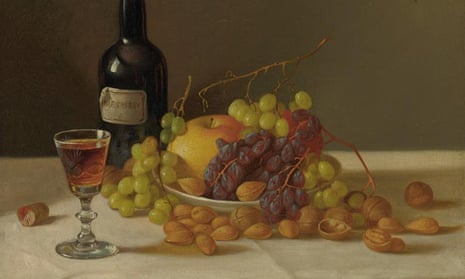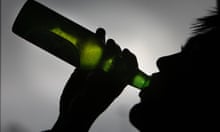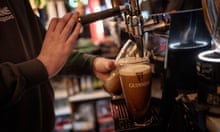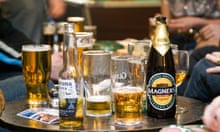Our Georgian and Victorian ancestors may have enjoyed a Christmas tipple but judging by the size of the glasses they used they probably drank less wine than we do today.
Scientists at the University of Cambridge have found that the capacity of wine glasses has ballooned nearly seven-fold over the past 300 years, rising most sharply in the last two decades in line with a surge in wine consumption.
Wine glasses have swelled in size from an average capacity of 66ml in the early 1700s to 449ml today, the study reveals – a change that may have encouraged us to drink far more than is healthy. Indeed, a typical wine glass 300 years ago would only have held about a half of today’s smallest “official” measure of 125ml.
In the first UK analysis of its kind, the university’s behaviour and health research unit quizzed antique experts and examined 18th-century glasses held at the Ashmolean museum in Oxford, glassware used at Buckingham Palace, and more recent glasses in John Lewis catalogues. The evidence was clear: the newer glasses were bigger.
The study, published on Wednesday in the BMJ, measured wine glass capacity from 1700 to the present day to help understand whether any changes in their size might have contributed to the rise in wine consumption.
“Wine will no doubt be a feature of some merry Christmas nights, but when it comes to how much we drink, wine glass size probably does matter,” said Prof Theresa Marteau, director of the Behaviour and Health Research Unit at the University of Cambridge, who led the research.
In 2016, Marteau and her colleagues carried out an experiment at the Pint Shop in Cambridge, altering the size of wine glasses while keeping the serving sizes the same. They found this led to an almost 10% increase in sales.
For the new study, the researchers obtained measurements of 411 glasses from 1700 to the modern day. They found wine glass capacity increased from 66ml in the 1700s to 417ml in the 2000s, with the mean wine glass size in 2016-17 even higher at 449ml.
“Wine glasses became a common receptacle from which wine was drunk around 1700,” says first author Dr Zorana Zupan. “This followed the development of lead crystal glassware by George Ravenscroft in the late 17th century, which led to the manufacture of less fragile and larger glasses than was previously possible.”
The paper points out that alcohol is the fifth largest risk factor for premature mortality and disability in high income countries. In England, the type of alcohol and volume consumed has fluctuated over the last 300 years, in response to economic, legislative and social factors. Significantly, wine consumption increased almost fourfold between 1960 and 1980, and almost doubled again between 1980 and 2004, a trend attributed to better marketing and licensing liberalisation which allowed supermarkets to compete in the lucrative drinks retail business.
“Our findings suggest that the capacity of wine glasses in England increased significantly over the past 300 years,” added Zupan. “Since the 1990s, the size has increased rapidly. Whether this led to the rise in wine consumption in England, we can’t say for certain, but a wine glass 300 years ago would only have held about a half of today’s small measure.”
The strength of wine sold in the UK has also increased since the 1990s, adding to the amount of pure alcohol being consumed by wine drinkers.
Q&ALarge wine glasses: fashion or marketing ploy?
Show
It’s the pubs’ and bars’ equivalent of supermarkets putting sweets by the checkout. The fashion for larger glasses – whether they are filled to the top or not – simply encourages people to drink (and spend) more than they need. Larger, stylish wine glasses can also increase the pleasure from drinking wine, which may also increase the desire to drink more.
In England, the type of alcohol and volume consumed has fluctuated over the last 300 years, largely in response to economic, legislative and social factors. Until the second half of the 20th century, beer and spirits (often watered down) were the most common forms of alcohol consumed, with wine generally the tipple of the upper classes.
In the 1930s and 1940s fortified wines were popular but wine took off when package holidays introduced Britons to exotic European tastes and law changes allowed UK supermarkets to compete in the sector.
Alcohol strength has also gone up significantly due to the public’s taste for riper, softer wines that are ready to drink. Wines like Bordeaux and Rioja that used to be about 12.5%-13% abv are often now 14% or more.
In England, wine is increasingly served in pubs and bars in 250ml servings, with smaller measures of 125ml often absent from wine lists or menus despite a regulatory requirement that licensees make customers aware of them.
The Wine and Spirits Trade Association said sociological trends were probably part of the reason for the growing wine glasses.
“The size of a wine glass reflects the trend and fashions of the time and is often larger for practical reasons” said the WSTA chief executive Miles Beale. “Red wine, for example, is served in a larger glass to allow it to breathe, something which perhaps wasn’t a priority 300 years ago.”











Comments (…)
Sign in or create your Guardian account to join the discussion